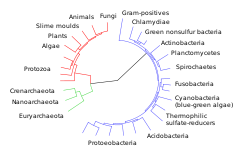- Digital organism
-
Part of a series on Evolutionary Biology  Key TopicsHistory of TheoryNatural HistorySocial ImplicationsFields & Applications
Key TopicsHistory of TheoryNatural HistorySocial ImplicationsFields & ApplicationsEvolutionary Biology Portal
Category • Related topics • BookA digital organism is a self-replicating computer program that mutates and evolves. Digital organisms are used as a tool to study the dynamics of Darwinian evolution, and to test or verify specific hypotheses or mathematical models of evolution. This is closely related to the area of artificial life.
History
Digital organisms can be traced back to the game Darwin in which computer programs had to compete with each other to stop one another from executing (Aleph-Null, "Computer Recreations", Software: Practice and Experience, vol. 2, pp. 93–96, 1972). A similar implementation that followed was the game Core War. In Core War, it turned out that one of the winning strategies was to replicate as fast as possible, which had the result that the opponent was deprived of all computational resources. Programs in the Core War game are also able to mutate themselves and each other by overwriting instructions in the simulated "memory" in which this game took place. This allowed competing programs to embed damaging instructions in each other that caused errors (terminating the process that reads it), "enslave processes" (making an enemy program work for you), or even change strategies mid-game and heal themselves.
Steen Rasmussen at Los Alamos National Laboratory took the idea from Core War one step further in his core world system. He introduced a genetic algorithm that would automatically write programs. However, Rasmussen did not observe the evolution of complex and stable programs. It turned out that the programming language in which core world programs were written was very brittle, and more often than not mutations would completely destroy the functionality of a program.
The first to solve the issue of program brittleness was Tom Ray with his Tierra system. Tierra was similar to core world. However, Ray made some key changes to the programming language such that mutations were much less likely to destroy a program. With these modifications, he observed for the first time computer programs that did indeed evolve in a meaningful and complex way.
Later, Chris Adami, Titus Brown, and Charles Ofria started developing their Avida system, which was inspired by Tierra but had again some crucial differences. In Tierra, all programs lived in the same address space, and could potentially overwrite or otherwise interfere with each other. In Avida, on the other hand, each program lives in its own address space. Through this modification, experiments with Avida became much cleaner and easier to interpret than those with Tierra. With Avida, digital organism research has begun to be accepted as a valid contribution to evolutionary biology by a growing number of evolutionary biologists. Evolutionary biologist Richard Lenski of Michigan State University has used Avida extensively in his work. Lenski, Adami, and their colleagues have published in journals such as Nature and the Proceedings of the National Academy of Sciences (USA).
In 1996, Andy Pargellis created a Tierra-like system called Amoeba that evolved self-replication from a randomly seeded initial condition.
See also
- List of digital organism simulators
- Artificial life
- Evolution@Home
- Genetic algorithms
- Combinatorial optimization
- Cellular automaton
Further reading
- O'Neill, B. (2003). Digital Evolution. PLoS Biology 1, 011-014.
- Wilke, C.O. & Adami, C. (2002). The biology of digital organisms. Trends in Ecology and Evolution 17, 528-532.
- Pargellis, A.N. (1996). The spontaneous generation of digital "Life". Physica D 91 86-96
- Misevic, Dusan & Ofria, Charles & Lenski, Richard E. Sexual reproduction reshapes the genetic architecture of digital organisms Proc Biol Sci. 2006 February 22; 273(1585): 457–464.
Basic topics in evolutionary biology Evidence of common descent Processes of evolution Population genetic mechanisms Evolutionary developmental
biology (Evo-devo) conceptsEvolution of organs
and biological processesAging · Avian flight · Cellular · DNA · Eye · Flagella · Hair · Human intelligence · Mammalian auditory ossicles · Mosaic evolution · Multicellular · SexTaxa evolution Modes of speciation History of evolutionary thought Charles Darwin · On the Origin of Species · Modern evolutionary synthesis · Gene-centered view of evolution · Life (classification trees)Other subfields List of evolutionary biology topics · Timeline of evolution Categories:- Artificial life
- Evolutionary biology
- Organisms
Wikimedia Foundation. 2010.
